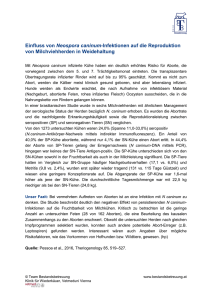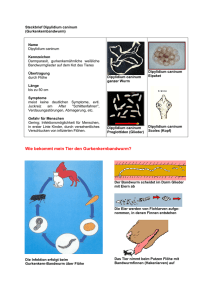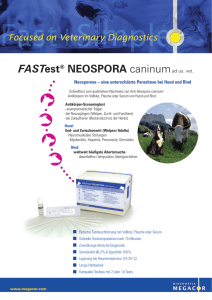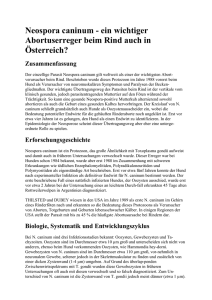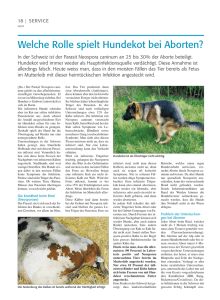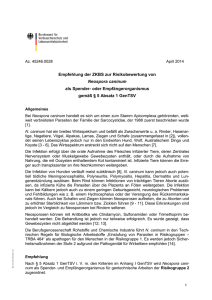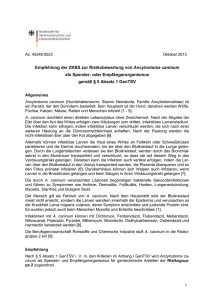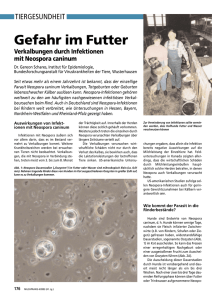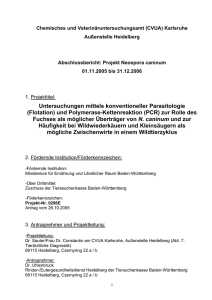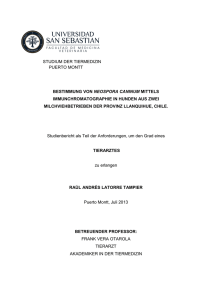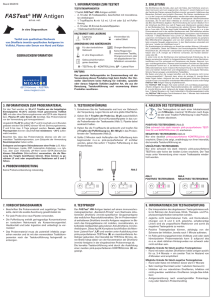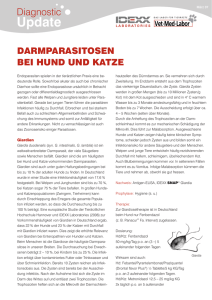FASTest® NEOSPORA caninum
Werbung
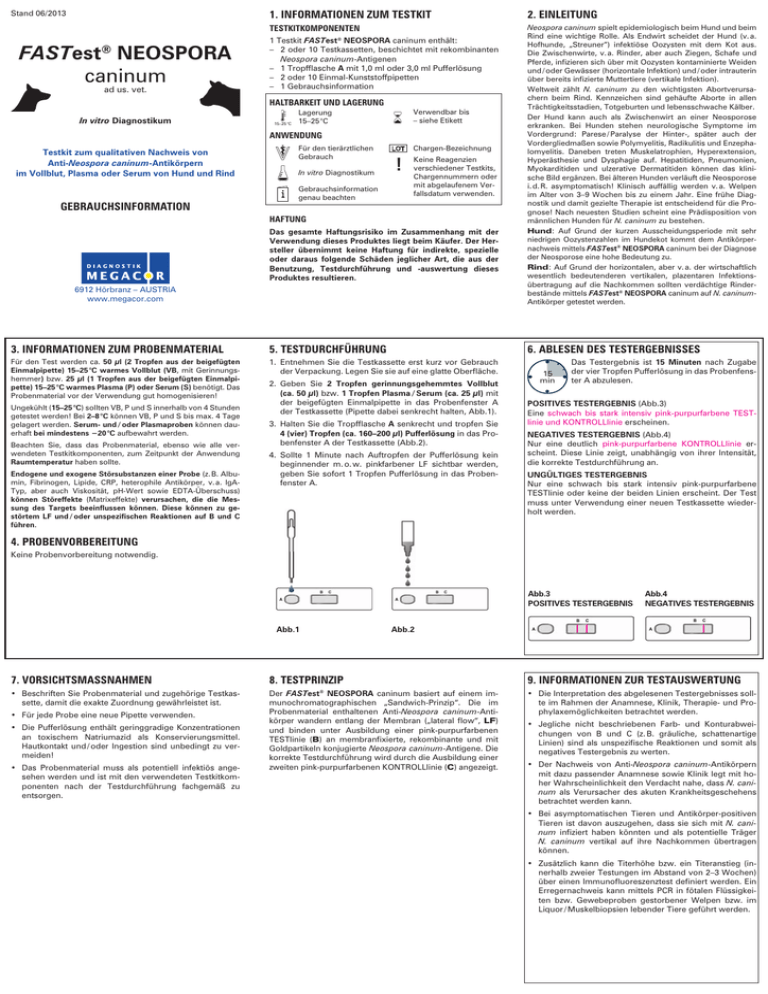
Stand 06/2013 FASTest® NEOSPORA caninum ad us. vet. 1. INFORMATIONEN ZUM TESTKIT 2. EINLEITUNG TESTKITKOMPONENTEN Neospora caninum spielt epidemiologisch beim Hund und beim Rind eine wichtige Rolle. Als Endwirt scheidet der Hund (v. a. Hofhunde, „Streuner”) infektiöse Oozysten mit dem Kot aus. Die Zwischenwirte, v. a. Rinder, aber auch Ziegen, Schafe und Pferde, infizieren sich über mit Oozysten kontaminierte Weiden und / oder Gewässer (horizontale Infektion) und / oder intrauterin über bereits infizierte Muttertiere (vertikale Infektion). Weltweit zählt N. caninum zu den wichtigsten Abortverursachern beim Rind. Kennzeichen sind gehäufte Aborte in allen Trächtigkeitsstadien, Totgeburten und lebensschwache Kälber. Der Hund kann auch als Zwischenwirt an einer Neosporose erkranken. Bei Hunden stehen neurologische Symptome im Vordergrund: Parese / Paralyse der Hinter-, später auch der Vordergliedmaßen sowie Polymyelitis, Radikulitis und Enzephalomyelitis. Daneben treten Muskelatrophien, Hyperextension, Hyperästhesie und Dysphagie auf. Hepatitiden, Pneumonien, Myokarditiden und ulzerative Dermatitiden können das klinische Bild ergänzen. Bei älteren Hunden verläuft die Neosporose i. d. R. asymptomatisch! Klinisch auffällig werden v. a. Welpen im Alter von 3–9 Wochen bis zu einem Jahr. Eine frühe Diagnostik und damit gezielte Therapie ist entscheidend für die Prognose! Nach neuesten Studien scheint eine Prädisposition von männlichen Hunden für N. caninum zu bestehen. Hund: Auf Grund der kurzen Ausscheidungsperiode mit sehr niedrigen Oozystenzahlen im Hundekot kommt dem Antikörpernachweis mittels FASTest® NEOSPORA caninum bei der Diagnose der Neosporose eine hohe Bedeutung zu. Rind: Auf Grund der horizontalen, aber v. a. der wirtschaftlich wesentlich bedeutenderen vertikalen, plazentaren Infektionsübertragung auf die Nachkommen sollten verdächtige Rinderbestände mittels FASTest® NEOSPORA caninum auf N. caninumAntikörper getestet werden. 1 Testkit FASTest® NEOSPORA caninum enthält: – 2 oder 10 Testkassetten, beschichtet mit rekombinanten Neospora caninum-Antigenen – 1 Tropfflasche A mit 1,0 ml oder 3,0 ml Pufferlösung – 2 oder 10 Einmal-Kunststoffpipetten – 1 Gebrauchsinformation HALTBARKEIT UND LAGERUNG In vitro Diagnostikum 15–25 °C Verwendbar bis – siehe Etikett Lagerung 15–25 °C ANWENDUNG Testkit zum qualitativen Nachweis von Anti-Neospora caninum-Antikörpern im Vollblut, Plasma oder Serum von Hund und Rind GEBRAUCHSINFORMATION Für den tierärztlichen Gebrauch In vitro Diagnostikum Gebrauchsinformation genau beachten LOT ! Chargen-Bezeichnung Keine Reagenzien verschiedener Testkits, Chargennummern oder mit abgelaufenem Verfallsdatum verwenden. HAFTUNG Das gesamte Haftungsrisiko im Zusammenhang mit der Verwendung dieses Produktes liegt beim Käufer. Der Hersteller übernimmt keine Haftung für indirekte, spezielle oder daraus folgende Schäden jeglicher Art, die aus der Benutzung, Testdurchführung und -auswertung dieses Produktes resultieren. 6912 Hörbranz – AUSTRIA www.megacor.com 6. ABLESEN DES TESTERGEBNISSES 3. INFORMATIONEN ZUM PROBENMATERIAL 5. TESTDURCHFÜHRUNG Für den Test werden ca. 50 µl (2 Tropfen aus der beigefügten Einmalpipette) 15–25 °C warmes Vollblut (VB, mit Gerinnungshemmer) bzw. 25 µl (1 Tropfen aus der beigefügten Einmalpipette) 15–25 °C warmes Plasma (P) oder Serum (S) benötigt. Das Probenmaterial vor der Verwendung gut homogenisieren! 1. Entnehmen Sie die Testkassette erst kurz vor Gebrauch der Verpackung. Legen Sie sie auf eine glatte Oberfläche. Ungekühlt (15–25 °C) sollten VB, P und S innerhalb von 4 Stunden getestet werden! Bei 2–8 °C können VB, P und S bis max. 4 Tage gelagert werden. Serum- und / oder Plasmaproben können dauerhaft bei mindestens −20 °C aufbewahrt werden. Beachten Sie, dass das Probenmaterial, ebenso wie alle verwendeten Testkitkomponenten, zum Zeitpunkt der Anwendung Raumtemperatur haben sollte. Endogene und exogene Störsubstanzen einer Probe (z. B. Albumin, Fibrinogen, Lipide, CRP, heterophile Antikörper, v. a. IgATyp, aber auch Viskosität, pH-Wert sowie EDTA-Überschuss) können Störeffekte (Matrixeffekte) verursachen, die die Messung des Targets beeinflussen können. Diese können zu gestörtem LF und / oder unspezifischen Reaktionen auf B und C führen. 2. Geben Sie 2 Tropfen gerinnungsgehemmtes Vollblut (ca. 50 µl) bzw. 1 Tropfen Plasma / Serum (ca. 25 µl) mit der beigefügten Einmalpipette in das Probenfenster A der Testkassette (Pipette dabei senkrecht halten, Abb.1). 3. Halten Sie die Tropfflasche A senkrecht und tropfen Sie 4 (vier) Tropfen (ca. 160–200 µl) Pufferlösung in das Probenfenster A der Testkassette (Abb.2). 4. Sollte 1 Minute nach Auftropfen der Pufferlösung kein beginnender m. o. w. pinkfarbener LF sichtbar werden, geben Sie sofort 1 Tropfen Pufferlösung in das Probenfenster A. 15 min Das Testergebnis ist 15 Minuten nach Zugabe der vier Tropfen Pufferlösung in das Probenfenster A abzulesen. POSITIVES TESTERGEBNIS (Abb.3) Eine schwach bis stark intensiv pink-purpurfarbene TESTlinie und KONTROLLlinie erscheinen. NEGATIVES TESTERGEBNIS (Abb.4) Nur eine deutlich pink-purpurfarbene KONTROLLlinie erscheint. Diese Linie zeigt, unabhängig von ihrer Intensität, die korrekte Testdurchführung an. UNGÜLTIGES TESTERGEBNIS Nur eine schwach bis stark intensiv pink-purpurfarbene TESTlinie oder keine der beiden Linien erscheint. Der Test muss unter Verwendung einer neuen Testkassette wiederholt werden. 4. PROBENVORBEREITUNG Keine Probenvorbereitung notwendig. Abb.3 POSITIVES TESTERGEBNIS Abb.1 Abb.4 NEGATIVES TESTERGEBNIS Abb.2 7. VORSICHTSMASSNAHMEN 8. TESTPRINZIP 9. INFORMATIONEN ZUR TESTAUSWERTUNG • Beschriften Sie Probenmaterial und zugehörige Testkassette, damit die exakte Zuordnung gewährleistet ist. Der FASTest® NEOSPORA caninum basiert auf einem immunochromatographischen „Sandwich-Prinzip“. Die im Probenmaterial enthaltenen Anti-Neospora caninum-Antikörper wandern entlang der Membran („lateral flow“, LF) und binden unter Ausbildung einer pink-purpurfarbenen TESTlinie (B) an membranfixierte, rekombinante und mit Goldpartikeln konjugierte Neospora caninum-Antigene. Die korrekte Testdurchführung wird durch die Ausbildung einer zweiten pink-purpurfarbenen KONTROLLlinie (C) angezeigt. • Die Interpretation des abgelesenen Testergebnisses sollte im Rahmen der Anamnese, Klinik, Therapie- und Prophylaxemöglichkeiten betrachtet werden. • Für jede Probe eine neue Pipette verwenden. • Die Pufferlösung enthält geringgradige Konzentrationen an toxischem Natriumazid als Konservierungsmittel. Hautkontakt und / oder Ingestion sind unbedingt zu vermeiden! • Das Probenmaterial muss als potentiell infektiös angesehen werden und ist mit den verwendeten Testkitkomponenten nach der Testdurchführung fachgemäß zu entsorgen. • Jegliche nicht beschriebenen Farb- und Konturabweichungen von B und C (z. B. gräuliche, schattenartige Linien) sind als unspezifische Reaktionen und somit als negatives Testergebnis zu werten. • Der Nachweis von Anti-Neospora caninum-Antikörpern mit dazu passender Anamnese sowie Klinik legt mit hoher Wahrscheinlichkeit den Verdacht nahe, dass N. caninum als Verursacher des akuten Krankheitsgeschehens betrachtet werden kann. • Bei asymptomatischen Tieren und Antikörper-positiven Tieren ist davon auszugehen, dass sie sich mit N. caninum infiziert haben könnten und als potentielle Träger N. caninum vertikal auf ihre Nachkommen übertragen können. • Zusätzlich kann die Titerhöhe bzw. ein Titeranstieg (innerhalb zweier Testungen im Abstand von 2–3 Wochen) über einen Immunofluoreszenztest definiert werden. Ein Erregernachweis kann mittels PCR in fötalen Flüssigkeiten bzw. Gewebeproben gestorbener Welpen bzw. im Liquor / Muskelbiopsien lebender Tiere geführt werden. Version 06/2013 FASTest® NEOSPORA caninum ad us. vet. 1. INFORMATION ON THE TEST-KIT 2. INTRODUCTION TEST-KIT COMPONENTS Neospora caninum plays an important epidemiological role in dogs and cattle. The dog (esp. watch dogs, stray dogs) is a definitive host and excretes infectious oocysts with the feces. The intermediate host, especially cattle, but also goats, sheep and horse, gets infected via grazing land and / or water contaminated with oocysts (horizontal infection) and / or intrauterine via already infected mothers (vertical infection). N. caninum plays an important role in abortion in cattle worldwide. Characteristics are accumulating abortions in all states of gestation, dead births and weak calves. The dog can act as an intermediate host as well and therefore can fall sick with Neosporosis. In dogs, the symptoms are especially focused on neurological disorders: paresis / paralysis of the hind-limbs, later also of the fore-limbs, as well as polymyelitis, radiculitis and encephalomyelitis. Also, muscular atrophy, hyperextension, hyperaesthesia and dysphagia can occur. Additionally, hepatitis, pneumonitis, myocarditis and ulcerative dermatitis can appear. In older dogs Neospora infection usually is asymptomatic! Puppies become clinically conspicuous at the age from 3 to 9 weeks up to one year. Early diagnostics and therefore specific therapy are essential for the prognosis. Due to recent studies, there seems to be a predisposition of male dogs to N. caninum. Dog: Due to the short excretion period and the low amount of oocysts in dog feces, the detection of antibodies using FASTest® NEOSPORA caninum becomes very important for the diagnosis of a Neosporosis. Cattle: Due to horizontal, but particularly to the economically more important vertical placental transmission of infection onto the offspring, with FASTest® NEOSPORA caninum suspicious stocks should be tested for N. caninum antibodies. 1 test-kit FASTest® NEOSPORA caninum contains: – 2 or 10 test cassettes coated with recombinant Neospora caninum antigens – 1 dropper bottle A with 1.0 ml or 3.0 ml buffer diluent – 2 or 10 disposable plastic pipettes – 1 instructions for use STABILITY AND STORAGE In vitro diagnosticum 15–25 °C Expiry date – see label Store at 15–25 °C APPLICATION Test-kit for the qualitative detection of anti-Neospora caninum antibodies in whole blood, plasma or serum of the dog and cattle For veterinary use only In vitro diagnosticum LOT ! Follow instructions for use precisely INSTRUCTIONS FOR USE Lot number Do not use test-kit components from different kits, lot numbers or beyond stated expiry date. LIABILITY The entire risk due to the performance of this product is assumed by the purchaser. The manufacturer shall not be liable for indirect, special or consequential damages of any kind resulting from the use of this product. 6912 Hörbranz – AUSTRIA www.megacor.com 6. READING OF THE TEST RESULT 3. INFORMATION ON THE SPECIMEN MATERIAL 5. TEST PROCEDURE Approximately 50 µl (2 drops of attached plastic pipette) 15– 25 °C warm whole blood (WB, with anticoagulant) or 25 µl (1 drop of attached plastic pipette) 15–25 °C warm plasma (P) or serum (S) are needed. Mix the sample material well before use! 1. Remove the test cassette from its foil pouch shortly before use. Place it on a flat surface. Non-cooled (15–25 °C), WB, P and S should be tested within 4 hours! At 2–8 °C, WB, P and S can be stored up to 4 days. Serum and / or plasma samples can be permanently stored at minimum −20 °C. Keep in mind that the sample material, as well as all used test-kit components, should have reached room temperature at the time of application. Endogeneous and exogeneous interfering substances of the sample (e. g. albumin, fibrinogen, lipids, CRP, heterophilic antibodies, especially type IgA, as well as viscosity, pH-value and excess EDTA) can cause interferences (matrix effects) that can influence the target measurement. These can lead to an impaired LF and / or unspecific reactions on B and C. 2. Add 2 drops of anticoagulated whole blood (ca. 50 µl) or 1 drop of plasma / serum (ca. 25 µl) with the attached plastic pipette into the sample window A of the test cassette (hold the pipette vertically, fig.1). 3. Hold the dropper bottle A vertically and express 4 (four) drops (160–200 µl) of buffer diluent into the sample window A of the test cassette (fig.2). 4. Add 1 additional drop of buffer diluent into the sample window A if there is no beginning LF visible within 1 minute after adding the buffer diluent. 15 min Read the test result 15 minutes after the four drops have beed added into the sample window A. POSITIVE TEST RESULT (fig.3) A weak to strong and well-defined pink-purple coloured TEST line and CONTROL line appear. NEGATIVE TEST RESULT (fig.4) Only a well-defined pink-purple CONTROL line appears. This line indicates, irrespective of its intensity, that the test has been performed properly. INVALID TEST RESULT Only a weak to strong and well-defined pink-purple TEST line or no line at all appears. The test should be repeated using a new test cassette. 4. SPECIMEN COLLECTION AND PREPARATION No specimen preparation necessary. fig.3 POSITIVE TEST RESULT fig.1 fig.4 NEGATIVE TEST RESULT fig.2 7. PRECAUTIONS FOR USERS 8. TEST PRINCIPLE 9. INFORMATION FOR THE INTERPRETATION • Label sample material and associated test cassette to ensure a precise assignment. The FASTest® NEOSPORA caninum is based on an immunochromatographic “sandwich principle” technique detecting specific anti-Neospora caninum antibodies in the whole blood, plasma or serum of the dog or cattle. The antiNeospora caninum antibodies of the sample are migrating (“lateral flow”, LF) along the nitrocellulose membrane and bind to fixed recombinant Neospora caninum antigens conjugated with gold particles forming a pink-purple coloured TEST line (B). A correct test procedure will be indicated by a second pink-purple CONTROL line (C). • The interpretation of the test result should always be based on anamnestic and clinical data as well as the therapy and prophylaxis possibilities. • Use a new pipette for each sample. • The buffer diluent contains low concentrations of toxic sodium azide as a preservative, therefore avoid skin contact and / or ingestion. • The sample material must be seen as potentially infectious and disposed of accordingly, together with the used test-kit components. • Any non-described colour or contour variation of B and C (e. g. greyish, shadow-like lines) has to be considered as unspecific reactions and therefore as negative test result. • The proof of anti-Neospora caninum antibodies, together with anamnesis and clinic shows with a high likelihood that N. caninum can be considered as cause of the acute disease. • In asymptomatic animals and antibody positive animals, one should assume that they could have been infected with N. caninum and, as potential carriers, can transmit N. caninum vertically on their offspring. • Additionally, the titre amount or the titre increase (within two tests in an interval of 2–3 weeks) can be defined via indirect immunofluorescence. A proof of the pathogen can be done by PCR in foetal fluids or tissue samples of deceased whelps or in the liquor / muscle biopsies of living animals.
